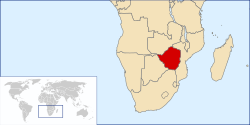
Back Suid-Rhodesië Afrikaans رودسيا الجنوبية Arabic رودسيا الجنوبيه ARZ جنوبی رودزیا AZB Паўднёвая Радэзія Byelorussian দক্ষিণ রোডেশিয়া Bengali/Bangla Colònia de Rhodèsia del Sud Catalan Jižní Rhodesie Czech Sydrhodesia Danish Südrhodesien German
Southern Rhodesia | |||||||||||||||||
|---|---|---|---|---|---|---|---|---|---|---|---|---|---|---|---|---|---|
| 1923–1980 | |||||||||||||||||
| Anthem: "God Save the King/Queen" | |||||||||||||||||
 | |||||||||||||||||
| Status | Self-governing British colony (1923–1965 1979-1980) | ||||||||||||||||
| Capital | Salisbury | ||||||||||||||||
| Common languages | English (official) Shona and Sindebele widely spoken, some Afrikaans | ||||||||||||||||
| Government | Constitutional monarchy | ||||||||||||||||
| Monarch | |||||||||||||||||
• 1923-1936 | George V | ||||||||||||||||
• 1936 | Edward VIII | ||||||||||||||||
• 1936–1952 | George VI | ||||||||||||||||
• 1952–1964[a] | Elizabeth II | ||||||||||||||||
• 1979–1980 | Elizabeth II | ||||||||||||||||
| Governor | |||||||||||||||||
• 1923–1928 (first) | John Chancellor | ||||||||||||||||
| Humphrey Gibbs | |||||||||||||||||
• 1979–1980 (last) | Christopher Soames | ||||||||||||||||
| Prime Minister | |||||||||||||||||
• 1923–1927 (first) | Charles Coghlan | ||||||||||||||||
• 1964[d] (last) | Ian Smith | ||||||||||||||||
| Legislature | Legislative Assembly | ||||||||||||||||
| History | |||||||||||||||||
| 1890–1923 | |||||||||||||||||
• Annexed by the UK | 12 September 1923 | ||||||||||||||||
| 1 October 1923 | |||||||||||||||||
| 1953–1963 | |||||||||||||||||
• UDI | 11 November 1965 | ||||||||||||||||
| 3 March 1970 | |||||||||||||||||
| 1 June 1979 | |||||||||||||||||
| 18 April 1980 | |||||||||||||||||
| Area | |||||||||||||||||
| 1904[1] | 372,518 km2 (143,830 sq mi) | ||||||||||||||||
| Population | |||||||||||||||||
• 1904[1] | 605,764 | ||||||||||||||||
| Currency | |||||||||||||||||
| |||||||||||||||||
| Today part of | Zimbabwe | ||||||||||||||||
| |||||||||||||||||
Southern Rhodesia was a landlocked self-governing British Crown colony in southern Africa, established in 1923 and consisting of British South Africa Company (BSAC) territories lying south of the Zambezi River.[2][3] The region was informally known as south Zambesia until annexed by Britain at the behest of Cecil Rhodes's British South Africa Company, for whom the colony was named. The bounding territories were Bechuanaland (Botswana), Northern Rhodesia (Zambia), Portuguese Mozambique (Mozambique), and the Transvaal Republic (for two brief periods instead the British Transvaal Colony, from 1910 the Union of South Africa, and then from 1961 the Republic of South Africa).
This southern region, known for its extensive gold reserves, was first purchased by the BSAC's Pioneer Column on the strength of a Mineral Concession extracted from its Matabele king, Lobengula, and various majority Mashona vassal chiefs in 1890. Though parts of the territory were laid claim to by the Bechuana and Portugal; its first people, the Bushmen or 'Khoisan' had possessed it from the very beginning of prehistory and had continued to inhabit some parts.[4] Following the colony's unilateral dissolution in 1970 by the Republic of Rhodesia government, the Colony of Southern Rhodesia was re-established in 1979 as the predecessor state to the Republic of Zimbabwe Rhodesia which in turn was the predecessor state of the Republic of Zimbabwe. Its only true geographical borders are the Zambezi and Limpopo Rivers, its other boundaries being more or less arbitrary and merging imperceptibly with the peoples and domains of earlier chiefdoms from pre-colonial times.
The British colony was established de jure in 1923, having earlier been occupied, constructed and administered by the British South Africa Company and its sub-concessionaires who were mostly British subjects. In 1953, it was merged into the Federation of Rhodesia and Nyasaland, which lasted until 1963. Southern Rhodesia was renamed Rhodesia and remained a de jure British colony until 1980. However, the Rhodesian government issued a Unilateral Declaration of Independence (UDI) in 1965 and established a fully independent Rhodesia, which immediately became an unrecognised state. In 1979, it reconstituted itself under majority rule as Zimbabwe Rhodesia, which also failed to win international recognition. After a period of interim British control following the Lancaster House Agreement in December 1979, the country achieved internationally recognised independence as Zimbabwe in April 1980.
- ^ a b "Census of the British empire. 1901". Openlibrary.org. 1906. p. 177. Archived from the original on 15 March 2016. Retrieved 26 December 2013.
- ^ "Southern Rhodesia Act 1965". legislation.gov.uk. 1965. Retrieved 5 June 2022.
- ^ "Southern Rhodesia Act 1979". legislation.gov.uk. 1979. Retrieved 5 June 2022.
- ^ The Ruined Cities of Mashonaland, J. Theodore Bent, Longmans, Green & Co., London, 1892.
© MMXXIII Rich X Search. We shall prevail. All rights reserved. Rich X Search

